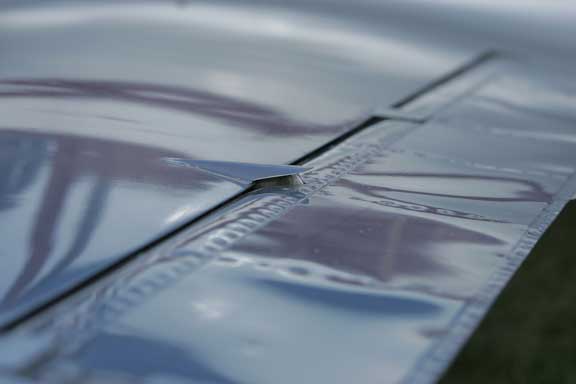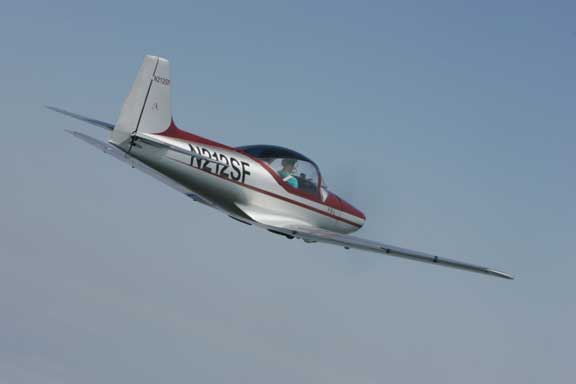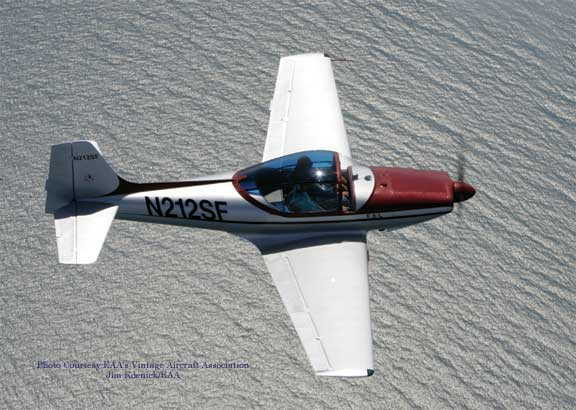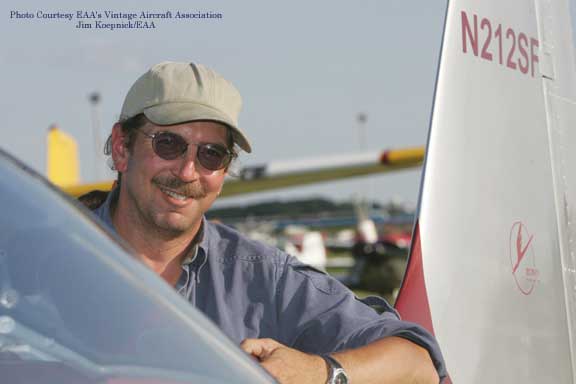Factory Falco
Plywood Butterfly Reborn
![]()
Factory Falco
|
|

“The interior was in shreds, and much of it was missing. The interior of a Falco is actually glued to the ultra-thin, 1/32 plywood that is glued to the inside of the fuselage as part of the structure, and most of that plywood was missing. The seat frames were there, and fortunately the rear seat and single belt were also there. Only a few Falcos were built with the child seat in the back that would accommodate a 66-pound child.”
Marc’s background in building canoes and kayaks became directly applicable in restoring the Falco.
“Many pieces, like the wing root fairings, were made the same way we’d make boats. You take two-inch wide strips of 1/32-inch veneer and glue them edge-to-edge at an angle over a form. Then, you glue another layer at an angle to the first layer. With that method you can make a plywood part of any shape and thickness. It sounds tedious but really isn’t. When I was doing the wing fairings, I even scabbed in some of the original fairings in an effort at keeping the airplane original.
“I’m much more comfortable with wood than I am with metal, but this airplane forced me to learn a lot of new skills. The cowling, for instance, had me using a shot bag and English wheel, but I was able to save it all without using Bondo.
“I’d never worked Plexiglas, and the windshield turned out to be different than Sequoia’s airplane in that it wasn’t a flatwrap. It had a slight compound curve to it, so we made up a mold and heat-formed the Plexiglas over it. I had to do the same thing for the nav light lenses in the wingtips.”
From the time when Marc first started speaking with Gar about the airplane, FAA paperwork was a major part of every conversation. The Falco, although theoretically certificated in the United States, was a victim of a classic Catch-22 situation.
“Part of the type certificate said the airplane had to be inspected by a representative of the FAA during construction to ensure that it conformed to the TC for it to be granted a standard airworthiness certificate in the U.S. The catch was that the type certificate wasn’t issued until 1961, and the airplanes went out of production in 1960, so there was no way that requirement could be met.
“Alfred Scott had run up against this with his airplane, and put the airplane in Experimental—Exhibition category. Gar was convinced I could get it into standard category, and that became one of my goals; I wanted to have the only Falco in history with a standard U.S. airworthiness certificate.

“In a lot of ways I was tremendously lucky to be doing this where I was because some key FAA people were located in my area. One of them worked for the local FSDO and was part of my ski patrol on the ski slopes I was managing. I was talking about my airplane problem with him, and he said, ‘You need to be talking with Bill Coppernoll. I’ll mention it to him.’
“One of the problems in taking this kind of project to the FAA,” Marc says, “is that there is no real reason for them to want to help you with it. The attitude in some places, especially after 9/11, is that the world really doesn’t need a certified, 200-mph, Italian two-place airplane, and to a certain extent, you can see their logic.
“I called Bill Coppernoll in the Milwaukee FSDO, and he was already familiar with my problem because of my ski patrol contact. Fortunately, Bill’s primary FAA job is certifying foreign aircraft that come into the U.S. for commercial purposes. For instance, he’s worked on aircraft like the Shorts Skyvan. So, we were talking about an area with which he was really familiar.”
It’s seldom a private airplane owner with a severe certification problem like Marc’s who stumbles on the right person at the FAA at the right time, but this was clearly the case with Bill Coppernoll.
“He came up to look at the airplane, and as he walked past it, he reached out and petted it. It was at that exact moment that I knew I stood a chance of making this work. He looked at me and said, ‘Why isn’t this a certified airplane?’ and I explained the problem. He then said, ‘This is why you pay your taxes, to get guys like me to work these things out.
“Bill said there had been a subtle change in the foreign type certification process, and in the case of the Falco, if I could prove beyond a shadow of a doubt that the airplane conformed exactly to the type certificate, as it was originally issued in 1961, then he’d be able to certify it in Utility category.”

Marc smiles as he remembers, “Bill got this serious look on his face and said, ‘If you do exactly as I say, it’ll work out, but if you give up and try to go experimental, I’ll fight you every inch of the way. You just have to be patient.’ He wanted this to work as much as I did.”
Marc’s challenge at that point was to come up with the proper Italian paperwork that documented his airplane’s construction and the type certificate to which it was certified.
“I had to find the Operations and Maintenance manual and have it translated, but when I tried that, it turned out that the translators didn’t know anything about technical stuff and wouldn’t certify that it was correct, so I had to find an engineer who translated it and notarized it as being correct. Then I had to do the same thing with the Pilot’s Operating Handbook, only it was in German. Then I had to find paperwork that tracked the airplane’s exportation to Germany and then from Germany to here.
“Bill’s attitude was, ‘If the airplane was being built today, I’d be the FAA rep inspecting it for the type certificate, and all I would be asking was whether it conformed to everything mentioned in the type certificate.’
“As it happens, my airplane was custom built for the German owner with a fixed-pitch prop, while the type certificate calls for a Hartzell constant-speed prop mounted on a [Lycoming] O-320-A1A, so I had to modify my airplane to that configuration.”
“While I was going through this, I had any number of experienced people tell me it couldn’t be done, but because of Bill Coppernoll’s direction and the help of a lot of other people, we made it work. Along the way I met some really interesting people, and it was exciting to be talking to Italy one day, Germany the next, and working with the translators.
“Along the way I came to really appreciate our own government. We may complain about how slowly they handle paperwork, but compared to many foreign governments, they are extremely efficient and lightning quick. Gar had tackled part of this before I got the airplane, and he actually had to go to Europe to get some of the documents because the people over there just weren’t helping.”
It would be logical to ask why Marc was willing to invest nearly a year of his time on the paperwork alone, when putting it in Exhibition category would have been so much easier and would not have affected his flying one bit.
He says, “It was a challenge. Here we were working on a one-of-a-kind project, and how often do you get a chance to be involved in something like that?”
Of course, the fact that it was a one-of-a-kind certified airplane caused other problems.
“When I needed an IA to do the final inspection, I had a little difficulty because whom do you ask to inspect an airplane when they’ve never seen one like it before? Again, I was lucky because Paul Anderson, a local IA, had worked with Bill Coppernoll on some foreign certifications and knew exactly what he’d be looking for. Besides, it’s a simple airplane.”
So now that it’s flying, what are his thoughts?
“First, I can’t believe I actually own this airplane. It’s a Ferrari. It handles like a dream. But, with the flaps down it could be a 150 on landing, and it’s so smooth in the air. There is simply nothing like it.
“A side thought on this is that flying a Falco was always a dream of my CFI, Caris Fryatt, who is extremely sick right now, so in some ways, we’ve accomplished his dream as well as mine, and that makes me feel good.
“Unfortunately, I’ve priced myself out of the Falco market. I’m flying an airplane that is worth so much that it is no longer carefree aviating because I have to think about what it is worth. The responsible thing to do for my family is to sell it, and I probably will, but I love this airplane so much. I can just sit and look at it, and it’s almost as much fun as actually flying it.
“One side benefit of getting the airplane certified is that now it will last forever regardless of what happens to it. As long as that dataplate exists, the airplane exists. What has been built once, can be built again, but without that certified dataplate you have no starting point.”
Like we said, the story of any airplane restoration always has its personal side, but this one is a little more personal than most.

Marc Stamsta
|
|